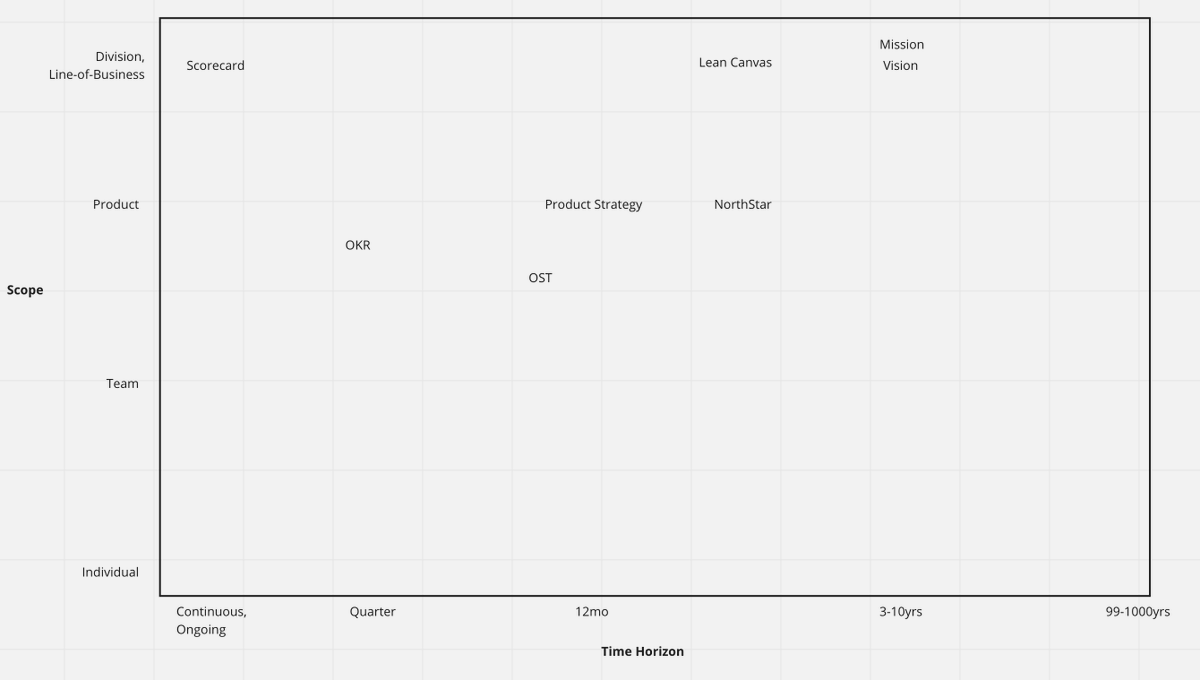Strategic Context
Summary: create multiple short consistent documents of your current business strategy/product strategy, to help people throughout the organization make decisions, generate ideas, etc.
Context: you're in an organization, esp a product-led business.
Forces
- you have multiple teams covering multiple specialties/functions
- actually I think this is an issue/opportunity even for a single team
- each team has its own focus and (maybe implied) metric for optimization and process (agile product development)
- but you want each to weigh that against a bigger picture of the overall goals/contexts/forces of the organization
- that bigger picture is both descriptive (here's what the market/customers look like) and prescriptive (here's how we plan to succeed)
- that context changes as external reality changes, and as internally narrative/planning changes
- that plan/narrative involves multiple scales and perspectives, so a single document is likely to seem incoherent to most readers.
Solution
- write multiple separate documents per the Cagan list below, each with the appropriate scale/scope
- keep each short: one-pager
- minimize inconsistency between them
- recognize that changes in 1 doc might require changes in another doc (even/esp during initial drafting: start by making "rough drafts" of each, then nudge each into consistency)
- recognize/communicate that they are subject to change (thinking in bets), and any member of the org should feel encouraged to escalate data points and perspectives that imply that the context is inaccurate or unlikely to succeed.
- keep a "current/agreed-to" version of each document, then make a fork-draft when a change is being tested, then when tests are resolved, have an explicit process of governance to bless/"commit" the change
Business Strategy etc providing context for tactical decisions.
Martin Cagan on Coaching - Strategic Context. Ensuring the product manager has the necessary understanding of the broader business context in which her team is operating.
Normally the strategic context is part of the onboarding for any new product manager joining the organization.
I don't see the actual Business Strategy below. Perhaps he thinks it's the union of all the Product Strategys? Or maybe his context is with more-established companies whose strategy isn't being discussed, and is operationalized into its Scorecard. Whereas in early-stage Product Management from MVP to Product-Market Fit the business strategy is much less clear, and a pivot might be needed.
Martin Cagan: Generally, there are six types of strategic context: (2020-01-09) Cagan Coaching Strategic Context
- Company Mission
- purpose
- why we are here.
- usually lasting for a decade or more, if not the life of the company.
- Company Scorecard
- set of key performance indicators (KPI’s)
- referred to here as the company scorecard, and sometimes as the company dashboard
- Company Objectives
- focused on for this year
- for each of these areas of improvement, there are typically specific business targets the company hopes to achieve (the key results). (OKR, North-Star Metric)
- Product Vision - shared across teams. (Business Model Canvas, Lean Canvas?)
- Normally the product vision is somewhere between 3 years and 10 years out.
- The mission may provide the purpose, but it’s the vision that begins to make this tangible. Includes Ideal Customer?
- This is what empowered product teams will be figuring out: how to make this vision a reality.
- Product Strategy - per single product team
- The product strategy drives the specific work that each product team is intended to tackle
- we’re no longer discussing the overall strategic context, and we’re now looking at an individual product team,
- Product Principles (manifesto)
I'm trying to map these out in terms of time and scope...
In my Quadruple-Loop Product Management page I compress these to 2 layers/loops (business/company level, and product/team level). (And add 2 other loops for execution: Problems/Opportunities, and Solutions.)
Hmm, is culture orthogonal to this?
I treat this as 1/3 of my agile product development triad: Agility, Context, and Team Agency.
Edited: | Tweet this! | Search Twitter for discussion


 Made with flux.garden
Made with flux.garden